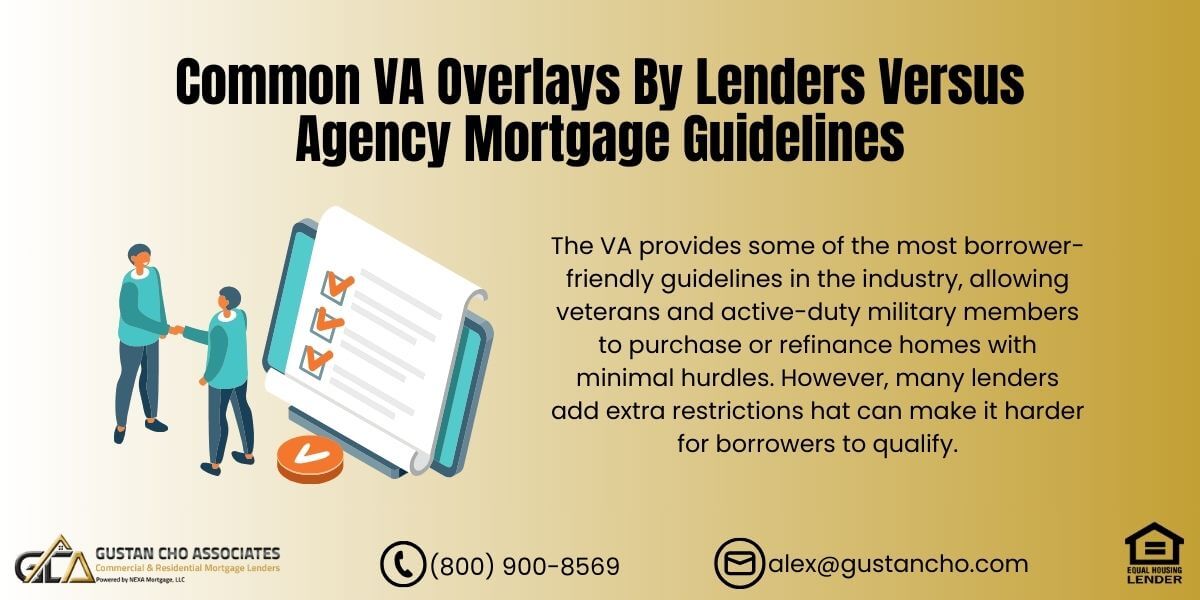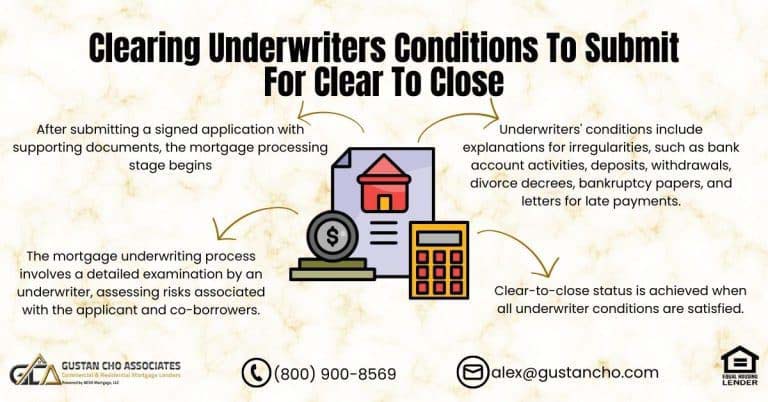Common VA Overlays: What You Need to Know for 2024
When it comes to VA loans, borrowers often need more information, particularly about qualifying for a loan. Many are told they don’t meet the requirements, even though they qualify under VA guidelines.
What’s the catch? It’s something called lender overlays—additional rules that individual lenders impose on top of the VA’s flexible guidelines.
At Gustan Cho Associates, we specialize in VA loans with no overlays, sticking strictly to VA guidelines. In this guide, we’ll explore common VA overlays, how they impact your ability to get a loan, and how you can avoid them altogether. Whether you’re buying a home or refinancing, this article will help you confidently navigate the VA loan process in 2024.
What Are VA Overlays?
VA overlays are additional lending requirements imposed by individual lenders that go beyond the VA’s official guidelines. The VA provides some of the most borrower-friendly guidelines in the industry, allowing veterans and active-duty military members to purchase or refinance homes with minimal hurdles. However, many lenders add extra restrictions—like higher credit score requirements or stricter debt-to-income (DTI) limits—that can make it harder for borrowers to qualify.
For example:
- The VA does not set a minimum requirement for credit score, but numerous lenders typically look for a score of 620 or above.
- The VA does not have a strict DTI cap, but some lenders impose a maximum DTI of 41-50%.
- The VA does not require borrowers to pay off collections or charge-offs, but many lenders insist on it.
Confused About VA Lender Overlays? Let Us Help You Navigate the Process!
Contact us today to learn how VA overlays differ from agency mortgages and find the best solution for you.
VA Loans in 2024: Updated Guidelines You Should Know
Before we discuss common VA overlays in more detail, let’s review the core benefits and requirements of VA loans as of 2024.
Key Features of VA Loans:
- No Down Payment: VA loans offer 100% financing, so no down payment is required.
- No Private Mortgage Insurance (PMI): Unlike conventional loans, VA loans don’t require monthly PMI, saving borrowers hundreds of dollars per month.
- Flexible Credit Requirements: The VA doesn’t mandate a minimum credit score; approval depends on your overall financial profile.
- No DTI Limit: As long as you receive an automated underwriting system (AUS) approval, there’s no hard cap on your DTI.
- Seller Concessions Allowed: Sellers can contribute up to 4% of the loan amount toward your closing costs.
Eligibility Requirements:
To be eligible for a VA loan, you need to:
- Be a currently serving military personnel, a veteran, or a qualified surviving spouse.
- Have a Certificate of Eligibility (COE), which proves your eligibility for VA financing.
- Meet the lender’s underwriting requirements (if they impose overlays).
The Impact of Common VA Overlays on Borrowers
1. Credit Score Overlays
The VA does not require a minimum credit score. However, many lenders have their own rules and often require a credit score of at least 620. This means that even if someone scores below 620, they might still qualify according to VA rules.
Pro Tip for 2024: Work with a lender like Gustan Cho Associates that doesn’t impose credit score overlays. We’ve helped borrowers with scores as low as 500 secure VA loans.
2. Debt-to-Income (DTI) Ratio Overlays
The VA doesn’t set a maximum DTI ratio. However, most lenders cap DTIs between 41% and 50%. This can disqualify veterans with higher DTIs, even if they meet other requirements.
Did You Know? Borrowers can still qualify with high DTIs if they have compensating factors, such as residual income above VA benchmarks.
3. Manual Underwriting Restrictions
The VA allows manual underwriting for borrowers who don’t receive automated approvals. However, many lenders avoid manual underwriting due to the additional work involved. This is another example of a common VA overlay that limits borrowers’ options.
4. Collections and Charge-Off Accounts
The VA doesn’t require borrowers to pay off collections or charge-offs. Yet many lenders insist on full payment before approving a loan.
For 2024: Focus on lenders like Gustan Cho Associates that follow VA guidelines and don’t require collections or charge-offs to be paid.
5. Bankruptcy and Foreclosure Waiting Periods
VA guidelines are more forgiving than most other loan programs when it comes to past financial hardships. For example:
- Chapter 7 Bankruptcy: 2-year waiting period after discharge.
- Chapter 13 Bankruptcy: Can qualify after 12 months of timely payments with consent from the trustee.
- Foreclosure or Short Sale: a 2-year waiting period.
Many lenders, however, impose overlays requiring longer waiting periods, such as 3 years for bankruptcy or foreclosure.
How to Avoid Common VA Overlays in 2024
Choose a Lender with No Overlays
Not all lenders follow the same rules. Some stick strictly to VA guidelines, while others add extra hurdles. At Gustan Cho Associates, we pride ourselves on being a no-overlay lender, meaning we follow VA guidelines to the letter.
Understand Your Options
If a lender denies your application, ask why. Is it because you don’t meet VA guidelines, or is it due to their overlays? Knowing the difference can help you find a lender better suited to your needs.
Work on Your Credit and Finances
While overlays can create roadblocks, improving your credit score and reducing your DTI ratio can make your loan application more attractive. Use 2024 as an opportunity to:
- Pay down high-interest debt.
- Avoid new credit inquiries before applying.
- Save for closing costs or reserves.
Get Pre-Approved with a No-Overlay Lender
Obtaining pre-approval from a lender without additional requirements helps you better understand your budget and prevent the annoyance of unexpected denials at the last minute.
Ready to Apply for a VA Loan? Understand Lender Overlays vs. Agency Guidelines!
Reach out now to explore how these overlays may affect your loan approval and how we can help you navigate the process.
Real-Life Success Stories: Overcoming VA Overlays
Case Study 1: Low Credit Score Approval
Challenge: A veteran with a 580 credit score was denied by multiple lenders due to their overlays. Solution: The borrower worked with Gustan Cho Associates, a no-overlay lender, and received AUS approval despite their low score.
Result: They closed on their dream home with 100% financing.
Case Study 2: High DTI Ratio
Challenge: A retired service member with a DTI ratio of 55% was turned away by a lender imposing a 41% DTI cap. Solution: Gustan Cho Associates evaluated their compensating factors and approved the loan with no overlays.
Result: They refinanced their existing mortgage, saving $400/month.
Why Choose Gustan Cho Associates for Your VA Loan?
At Gustan Cho Associates, we specialize in helping borrowers overcome challenges caused by common VA overlays. We’re proud to be a no-overlay lender, offering:
- Approvals are based on VA guidelines only.
- Flexible credit and DTI requirements.
- Expertise in manual underwriting.
- A seamless loan process from beginning to end.
If you’re ready to purchase or refinance a home in 2024, contact us at 800-900-8569, text us for faster responses, or email us at gcho@gustancho.com. Let us help you achieve your homeownership goals without the frustration of unnecessary overlays.
Conclusion
VA loans are one of the best financing options for veterans and active-duty service members, offering unmatched benefits like no down payment, no PMI, and flexible guidelines. However, common VA overlays imposed by many lenders can create unnecessary barriers. Partnering with a lender such as Gustan Cho Associates, which adheres to VA guidelines without any lender overlays, allows you to leverage your VA loan benefits in 2024 fully.
Don’t let lender overlays hold you back. Contact us today to get started!
Frequently Asked Questions About Common VA Overlays:
Q: What are Common VA Overlays?
A: Common VA overlays are extra rules that lenders add to the VA’s official guidelines, such as requiring a higher credit score or stricter debt-to-income (DTI) limits.
Q: Do All Lenders Have Common VA Overlays?
No, not all lenders have overlays. Some, like Gustan Cho Associates, follow VA guidelines strictly without adding extra requirements.
Q: In What Ways Do Typical VA Overlays Impact the Requirements for My Credit Score?
A: The VA does not require a minimum credit score, but many lenders impose overlays requiring a score of 620 or higher.
Q: What is the Impact of Common VA Overlays on My DTI Ratio?
A: While the VA doesn’t cap DTI ratios, common VA overlays may require a maximum DTI of 41% to 50%, making it harder for borrowers with higher DTIs to qualify.
Q: Can I qualify for a VA loan with collections on my credit report?
A: Yes, the VA allows loans without paying off collections. Still, common VA overlays might require you to pay off collections before approval.
Q: How Can I Avoid Common VA Overlays?
A: Work with a no-overlay lender like Gustan Cho Associates, which adheres strictly to VA guidelines and eliminates unnecessary hurdles.
Q: Despite Common VA Overlays, Can I Get a VA Loan After Bankruptcy or Foreclosure?
A: Yes, VA guidelines are lenient with waiting periods. Still, common VA overlays may extend those periods, so choosing the right lender is crucial.
Q: Do Common VA Overlays Affect Manual Underwriting?
A: Yes, some lenders with overlays avoid manual underwriting altogether, limiting options for borrowers who don’t qualify through automated systems.
Q: What are Examples of Common VA Overlays?
A: Common VA overlays include higher credit score requirements, stricter DTI caps, mandatory collection payments, and extended waiting periods after financial hardships.
Q: Why Choose a No-Overlay Lender for Your VA Loan?
A: A no-overlay lender, like Gustan Cho Associates, ensures your application is assessed based solely on VA guidelines, avoiding the obstacles caused by common VA overlays.
This blog about “Common VA Overlays By Lenders Versus Agency Guidelines” was updated on November 18th, 2024.
Struggling with VA Lender Overlays? Let’s Find the Right Loan for You!
Contact us now to find out how we can simplify the process for you.










